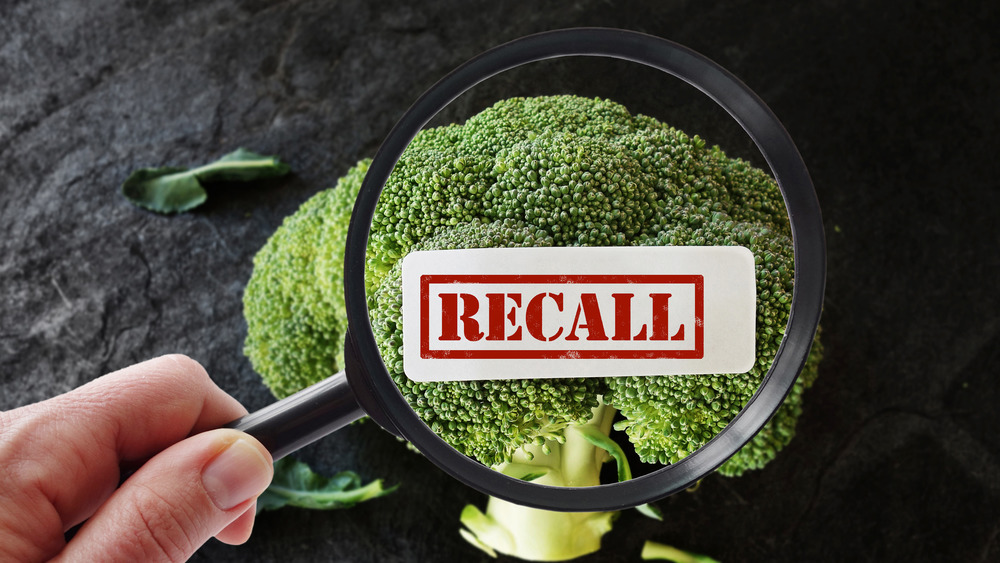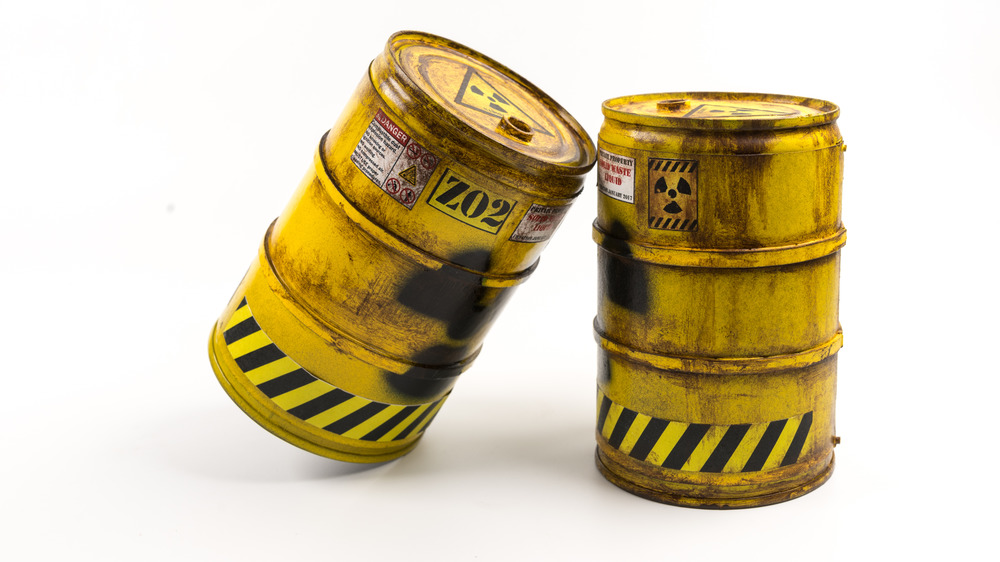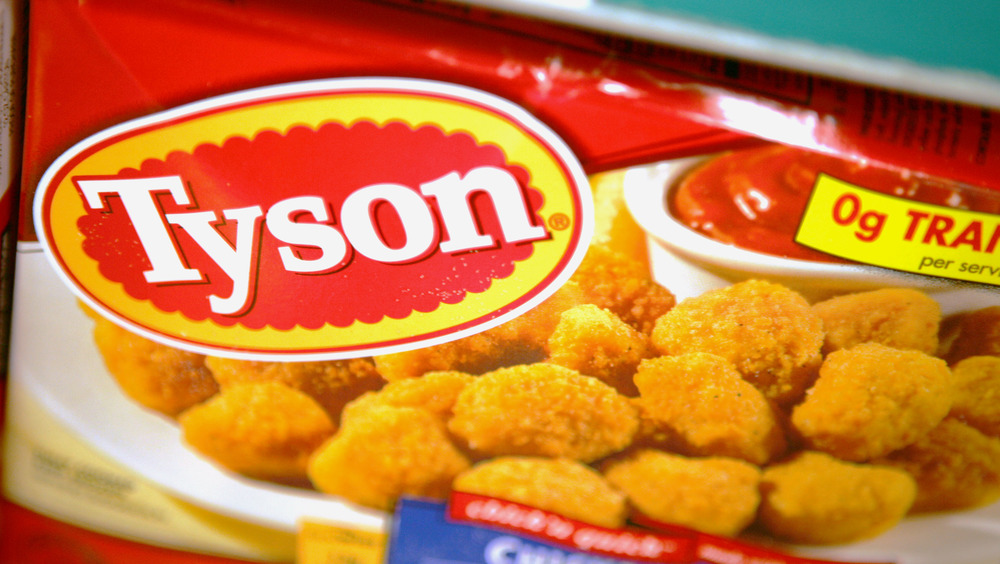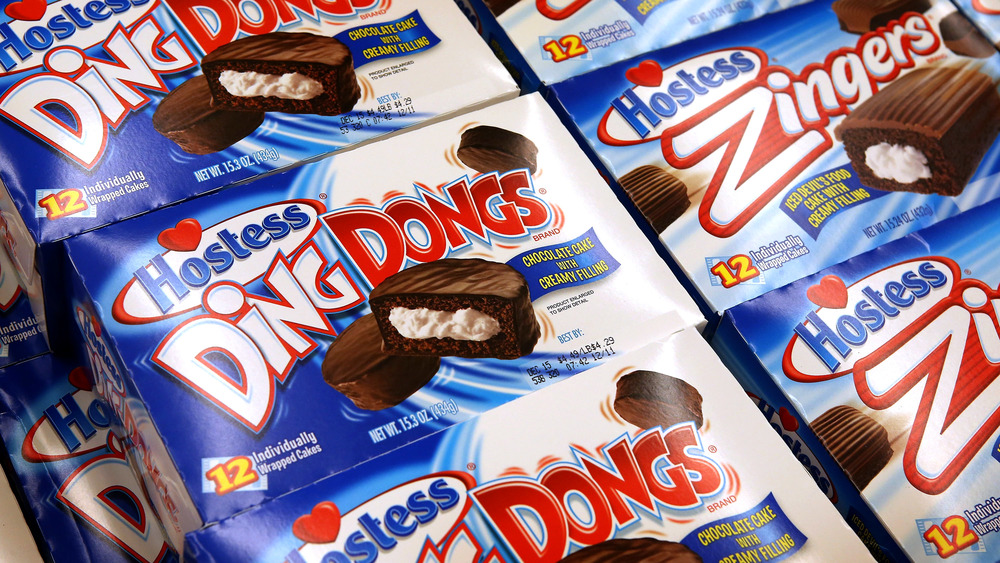Foods That Were Recalled For The Scariest Reasons
The first U.S. food recall, in 1920, involved canned olives that were contaminated with the bacteria that causes botulism (via Time). There'd been food "scandals" prior to that, including that time when dairy farmers allowed their milk-producing cows to feed on leftover whiskey mash, causing the death of 8,000 children (via Atlas Obscura), but it wasn't until after the creation of the U.S. Food and Drug Administration (FDA) in 1906 that recall culture really got going.
Fast-forward to 2019, the latest full year for which recall information is available from the USDA Food Safety and Inspection Service (FSIS), which saw 124 food recalls, affecting a total of 20,427,455 pounds of food. It's a massive uptick from, say, 2006, when there were just 34 recalls, amounting to under 6 million pounds. "What's happening is that our ability to identify outbreaks has dramatically improved due to new information technologies and laboratory techniques," explained former FDA Commissioner Scott Gottlieb, speaking in 2018. This technology is more capable of linking foodborne illness to its source.
But something else has been afoot in recent years with regard to food safety that has little to do with foodborne illness. The Washington Post reported more than 17 million of the 20,427,455 pounds of food recalled in 2019 was due to the presence of materials such as metal, plastic, and glass. Things weren't great in 2018 either. So, is it one step forward, two steps back for food safety? Not when you consider these scary reasons foods have been recalled over the years.
Salads recalled for containing extraneous animal matter
In April 2017, Fresh Express recalled its Organic Marketside Spring Mix over concerns it contained "extraneous animal matter," according to an announcement made by the FDA. What the announcement didn't state specifically was that the "extraneous animal matter" was none other than parts of a dead bat. As the Centers for Disease Control and Prevention (CDC) stated (via Forbes), "Two people in Florida reported eating some of the salad before the bat was found. The bat was sent to the CDC rabies lab for laboratory testing because bats in the United States sometimes have been found to have this disease. The deteriorated condition of the bat did not allow for CDC to definitively rule out whether this bat had rabies."
The salad had been purchased at Walmart, according to the FDA. The two individuals were referred for prophylactic rabies treatment, and follow-up by health officials noted no signs of the condition, according to Scientific American. While that is fortunate, it does not take away from the irony of people purchasing organic greens, presumably to avoid toxins, and ending up having to deal with two weeks of painful injections and, presumably, lingering trauma over having discovered dead bat parts in their food.
Frozen hash browns recalled for containing extraneous golf ball materials
Just a few weeks after the Fresh Express salad incident, it appeared to be "same bat time, same bat channel" — only this time, the food in question was frozen hash browns, and the stray material found in the food was "extraneous golf ball materials" (via the FDA). "Despite our stringent supply standards," the manufacturer of the hash browns, McCain Foods USA, Inc., said in a statement it appears the "golf ball materials" were "inadvertently harvested with [the] potatoes used to make this product." The hash browns had been sold to consumers throughout Illinois, Wisconsin, the Carolinas, Virginia, D.C., Delaware, Florida, Georgia, and Maryland.
Fortunately, it turned out that there were no physical injuries associated with consumption of McCain hash browns. But how on earth could "stringent supply standards" end up leading to golf ball parts in one's hash browns? Food safety specialist and North Carolina State professor, Ben Chapman, told Live Science that "large food companies will use mechanical harvesters to pick their produce products," which makes it entirely possible for foreign objects such as golf balls to end up in the supply chain.
Toxic Waste Bubblegum recalled for containing toxic levels of heavy metal
Super sour candy packaged under the name Toxic Waste Short Circuits Bubble Gum was found to contain an actual toxic chemical back in 2011, when the FDA's testing of the gum revealed elevated levels of lead in the amount equal to 0.189 parts per million (via Food Safety News). The FDA's upper limit for food products is 0.1 parts per million. So, we're talking almost twice the legal limit. And that's very, very bad when you consider how very, very toxic lead is.
Manufactured in Pakistan for the U.S. candy distributor, Candy Dynamics, the lead-contaminated bubble gum was distributed widely across the U.S. in retail stores and via mail order, as well as in limited quantities in Canada and Switzerland. Although Candy Dynamics reported that no one got sick from the lead-laden gum, there really is no way of knowing whether there were any long-term consequences to the babies, children, and pregnant women who might have been exposed to lead as a result (via NPR). According to the CDC, lead exposure can continue long after consumption of a food product containing lead. The reason? Once absorbed, lead stays in the bones, blood, and body tissue, leading to continued internal exposure.
Unsanitary chicken eggs recalled after inspection revealed hideously unsanitary conditions
In April 2018, a North Carolina farm with an Indiana-based parent company recalled more than 200 million chicken eggs that were distributed across the U.S. (via recall statement issued by the FDA) over concerns the eggs were contaminated with the bacteria, Salmonella Braenderup, which can cause fever, diarrhea, nausea, vomiting, and abdominal pain and in rare instances, can produce more severe illnesses such as endocarditis. The company, Rose Acre Farms, had been producing 2.3 million eggs per day on their North Carolina farm. Before the whole thing was over in June 2018, at least 45 people in ten states (including South Carolina, Virginia, New York, and Pennsylvania) had become infected, according to the CDC.
No deaths were reported. But the circumstances under which the recall came about were disturbing. Apparently, a multi-week inspection by the FDA of the North Carolina farm revealed a number of "unsanitary practices." These included sightings of multiple dead rats and multiple live rodents scurrying around manure piles (via Washington Post). It may be worth noting here that salmonella is nothing compared to the disease rats are most famous for spreading: plague, according to Mayo Clinic.
FDA agents also observed some really disgusting things the food workers were doing, including touching food products right after touching their hair, their face, and the garbage without washing their hands or changing their gloves first. Symptoms of salmonella include diarrhea, fever, and muscle cramping, according to the CDC.
Flour recalled after consumers noticed it contained something that looked like little white hairs
In September 2016, the Morrison Milling Company of Denton, Texas issued a recall for what was supposed to have been 100 percent whole wheat flour that had been distributed by H-E-B supermarkets (a Southern supermarket chain). As it turned out, it wasn't quite 100 percent flour at all. Apparently, a routine production line inspection revealed the possible presence of what appeared to be ... white hairs (via Food Safety News). The thing was, white hairs might have been more palatable than what the foreign contaminants turned out to be, which were "soft nylon fragments." It seemed they had gotten into the product through "a faulty screen at [the company's] manufacturing facility," but according to Scientific American, the company offered no explanation as to how the nylon fragments might have gotten into the production line in the first place.
The good news is that there were never any reports of consumers actually finding these nylon fragments that looked like hair in their flour.
Chicken nuggets recalled for concerns they contained pieces of hard plastic
Back in 2017, residents of a Kansas town were up in arms over the possible opening of a Tyson Foods, Inc. manufacturing facility, with their primary concern being environmental impact, according to Reuters, as well as "other issues." What may have been unspoken was the community's growing concern about Tyson's manufacturing practices. A little over one year earlier, Tyson recalled approximately 132,520 pounds of panko-breaded chicken nugget products due to concerns they contained pieces of hard plastic (via the USDA's FSIS).
The nuggets in question had been produced in July 2016, and the problem was discovered only after consumers complained of finding pieces of plastic in said nuggets, which ranged in size "from 21mm in length and 6.5mm in diameter," according to the FSIS. Tyson told the FSIS that while it passed its food products through a metal detector, it did not, at least at the time, have the technology to detect plastic in its food products. No one was injured, except, potentially Tyson's reputation.
Processed meats recalled over concerns they contained rubber and metal pieces
According to the Washington Post, between January and December of 2019, there were 34 recalls of processed meats suspected of containing things they weren't supposed to contain. Tyson Foods was responsible for five of them, according to Modern Farmer. The first was in January, of more than 36,000 pounds of frozen chicken nuggets that consumers complained were contaminated with pieces of rubber. The next was in March and involved over 69,000 pounds of various flavors of frozen breaded chicken strips in which consumers, who included school children and prison inmates (via Modern Farmer), found pieces of metal. On May 4, 2019, another 11,829,517 more pounds of Tyson's frozen, ready-to-eat chicken products were recalled under suspicion they contained metal; these had been exported to Hong Kong, Bermuda, and St. Maarten.
On June 7, 2019, Tyson recalled over 190,000 pounds of chicken fritters sold to school cafeterias, due to "hard plastic" contamination, as reported by schools, which had purchased the fritters for their cafeterias. Finally, more extraneous materials were found in Weaver chicken patties, manufactured by Tyson, in August 2019, although it's unclear what those materials were. However, it's worth noting that all five of these recalls was at a Class 1 level, meaning "there is a reasonable probability that the use of or exposure to a violative product will cause serious adverse health consequences or death" (via the FDA).
Frozen foods recalled after consumers discovered pieces of metal, glass, and plastic
Apparently, 2021 isn't getting off to such a great start when it comes to foreign objects found in frozen foods. On January 10, 2021, the FDA announced that Weis Markets had issued a recall of 10,869 48-ounce containers of Weis Quality Cookies and Cream Ice Cream and 502 3-gallon containers of Klein's Vanilla Dairy Ice Cream. The reason? Concerns that the ice ream contained "metal filling equipment parts." And why such concerns? Because at least one customer actually found an "intact piece of metal equipment" in their cookies and cream. Gross? Yes, but let's not forget this also posed a possible choking hazard, Weis Markets admitted.
Just days later, on January 15, 2021, the USDA's FSIS announced a recall of Hot Pockets (manufactured by Nestlé Prepared Foods) for suspected contamination with extraneous materials, which, in this case, were "pieces of glass and hard plastic." Of course, that's nothing compared to the Hot Pockets recall of 2014, which stemmed from "diseased and unsound" animals in the beef supply chain with regard to the Croissant Crust Philly Steak and Cheese (via CNBC).
Hostess snack cakes recalled after causing allergic reactions to peanuts
Junk food doesn't have to be bad for you. But sometimes it is, and sometimes it's downright scary, such as in 2016, when Hostess snack cakes were recalled over concerns that they contained undeclared peanut residue. It all started in April 2016, when one of Hostess's flour suppliers, Grain Craft, notified the FDA that a customer had discovered peanut residue in cookies made with Grain Craft flour. Further testing of the flour revealed traces of peanut protein, which can be deadly to someone with a peanut allergy (via Mayo Clinic). On April 30, Grain Craft stopped using the suspect flour, and subsequent sampling by the FDA found no further presence of peanut protein.
However, the FDA reported that by June 3, 2016, Hostess had already received notification that two children with peanut allergies had allergic reactions immediately after they ate Hostess donuts. At that point, Hostess tested its flour and found peanut residue. What followed was a recall of 700,000 cases of Ding Dongs, Zingers, Chocodiles, and donuts sold around the U.S. and Mexico.
Food recalled due to glass pieces
In March 2016, the food giant Nestlé initiated a voluntary recall of nearly 3 million boxes of an assortment of frozen foods after the company received complaints from consumers who said they had found pieces of broken glass in their food. The frozen foods affected were DiGiorno frozen pizzas, Lean Cuisine meals, and Stouffer's lasagnas and soufflés. However, what all the recalled foods had in common was spinach, according to a statement by the company (via News Leader), which is presumably the means by which any broken glass would have gotten into the food.
Luckily, it turned out that no injuries were reported. However, bits of broken glass continued to vex food manufacturers and consumers alike when less than a month later, on April 1, 2016, salty snack-maker Snyder's-Lance issued a press release to the effect that it was initiating a voluntary recall with regard to its Emerald 100-Calorie Packs of Roasted & Salted Cashew Halves & Pieces, which had been distributed widely across the U.S. The reason? The company had received a complaint stating that a consumer had found small pieces of glass in one such pack (via PRNewsire).
Odwalla juices recalled due to deadly E. coli outbreak
On October 31, 1996, the juice-maker Odwalla recalled all of its products containing unpasteurized apple juice. The Seattle-King County Department of Health linked the company's juices that had the apple juice as an ingredient to 13 reported cases of E. coli, according to the CDC. One child died due to complications from E. coli, and another 65 people from the western U.S. and British Columbia became sick. More than a dozen ended up with a potentially fatal condition called hemolytic uremic syndrome, which causes major organ failure, according to a 2009 Food Safety News report that was one of a 10-part series on the topic of "meaningful foodborne illness outbreaks."
All foodborne illness outbreaks are terrible, but what made this one so uniquely tragic was the fact that many of its victims were young children. According to the CDC, the median age of the 28 patients for whom it had information at the time was 5, with an age range from 1 to 41 years. In response to the outbreak, Odwalla began pasteurizing its juices, and the federal government began requiring warning labels to be placed on all unpasteurized juice containers.
Cantaloupes recalled after deadly outbreak of listeriosis
As tragic as the Odwalla juice outbreak of 1996 was, it has been said that the "absolute worst" recall of all time was the 2011 outbreak of listeriosis that killed at least 33 people, caused one pregnant woman to miscarry, and sickened a total of 147 people, according to a 2012 report by the CDC. Listeriosis is a serious infection caused by the germ Listeria monocytogenes, to which people can be exposed by consuming contaminated food. The infection, which presents with flu-like symptoms anywhere from two to eight weeks after exposure, "primarily affects pregnant women, newborns, older adults, and people with weakened immune systems," according to the CDC. While others might be exposed to the germ that causes listeriosis, people who do not fall within one of those groups rarely become sickened as a result of exposure (via the Mayo Clinic).
Although listeria bacteria is most commonly found in luncheon meats (via CDC), in the case of the 2011 outbreak, the culprit was cantaloupe.












